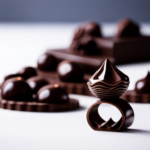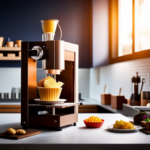Discover the groundbreaking world of 3D printing edible gifts and treats. This innovative approach merges culinary artistry with cutting-edge technology, offering limitless possibilities for creating delectable and visually striking gifts. From intricate confections to personalized confectionery, 3D printing opens up new avenues for culinary creativity.
Delve into the advantages of 3D printing edible creations. Explore the range of materials that can be used, the design techniques that can be employed, and the various printing methods available. Additionally, learn about the safety considerations involved in 3D printing food.
Embark on a journey of taste and innovation as we explore the intersection of food and technology. Join us in unlocking the potential of 3D printed edible gifts and treats.
The Advantages of 3D Printing Edible Gifts
The precision of 3D printing offers unique advantages for creating customized edible gifts with intricate details and designs. This cutting-edge technology enables the realization of intricate, personalized designs that were previously unattainable through traditional methods. The creative possibilities are endless, allowing for the production of bespoke edible gifts tailored to specific events, themes, or individuals.
From personalized cake toppers to intricately designed chocolates, 3D printing allows for the materialization of highly customized and visually stunning edible creations. This level of customization and attention to detail is unparalleled, providing an innovative way to elevate the presentation and personalization of edible gifts.
The ability to translate digital designs into edible treats opens up a world of creative possibilities, bringing to life unique and intricate patterns, shapes, and textures that would be challenging to achieve using conventional means. Moreover, 3D printing enables the efficient production of complex designs, offering a level of intricacy that adds a touch of sophistication to edible gifts.
Transitioning into the subsequent section, the choice of edible materials for 3D printing plays a crucial role in materializing these creative designs.
Types of Edible Materials for 3D Printing
Several edible materials are commonly used for 3D printing. Edible filament options such as chocolate, fondant, sugar, and even cheese are popular choices for creating intricate and customized edible designs. Each material offers unique properties that cater to different culinary applications.
For instance, chocolate is ideal for crafting detailed confectionery items, while sugar-based filaments can be utilized to produce delicate decorations for pastries and cakes. Fondant, on the other hand, provides a pliable medium for sculpting intricate cake toppers and figurines. Cheese-based filaments can be used to create savory garnishes and decorations for various dishes.
These edible materials are designed to meet the specific requirements of 3D printing in the culinary world, offering a wide range of possibilities for chefs, bakers, and confectioners to experiment with innovative designs and flavors. With these diverse options, 3D printing technology is revolutionizing the way edible creations are designed and customized, opening up new frontiers in culinary artistry and presentation.
Designing and Customizing Edible Creations
When designing and customizing edible creations for 3D printing, it is essential to consider the specific culinary applications and desired aesthetic outcomes. Customized confectionery and personalized pastry designs can be achieved through intricate detailing and unique shapes that may not be feasible using traditional methods.
With 3D printing, it is possible to create intricate and personalized designs that can elevate the visual appeal of edible treats. Furthermore, the ability to customize and tailor the design of edible creations provides an avenue for personalization, allowing for the incorporation of names, messages, or specific themes into the treats. This level of customization adds a unique and personalized touch to the edible gifts and treats, making them ideal for special occasions and events.
The use of specialized software enables the creation of intricate designs that can be translated into edible forms, offering endless possibilities for customization. Moving forward, it is essential to explore the various 3D printing techniques for edible treats to understand the technical aspects of bringing these customized creations to life.
3D Printing Techniques for Edible Treats
Designing and customizing edible creations for 3D printing opens up a world of possibilities for creating intricate and personalized designs that can be translated into edible forms, allowing for endless customization.
When it comes to 3D printing techniques for edible treats, culinary creativity is at the forefront. One of the key methods used is extrusion-based 3D printing, where edible materials such as chocolate, fondant, or dough are extruded layer by layer to build up the final edible creation. This technique allows for the formation of complex and delicate shapes that would be challenging to achieve using traditional methods.
Another innovative technique is powder-based 3D printing, which involves selectively solidifying layers of edible powder material, such as sugar or cocoa, using a liquid binding agent. This method enables the creation of intricate designs with fine details, making it ideal for crafting decorative elements for confectionery or pastry items.
Additionally, there are developments in using edible inks for 3D printing, allowing for vibrant and colorful edible decorations to be added to treats. These 3D printing techniques empower culinary artists to push the boundaries of traditional food design and create unique, personalized edible gifts and treats.
Transitioning into the subsequent section about safety and storage considerations for edible 3D printed gifts, it is crucial to ensure that the materials and processes used in 3D printing are safe for consumption and that the finished edible items are stored and handled appropriately to maintain their quality and safety.
Safety and Storage Considerations for Edible 3D Printed Gifts
Ensuring the safety and proper storage of edible 3D printed gifts is paramount in maintaining their quality and integrity. When considering food safety, it is essential to use food-grade materials and ingredients for the 3D printing process. Additionally, proper storage is crucial to preserve the freshness and taste of the edible treats.
To achieve this, the following safety and storage considerations should be taken into account:
-
Food Safety
-
Utilize food-safe 3D printing filaments and edible inks to ensure that the printed treats are safe for consumption.
-
Regularly clean and sanitize the 3D printing equipment to prevent any contamination during the manufacturing process.
-
Shelf Life
-
Store the 3D printed edible gifts in airtight containers to protect them from moisture and air, which can compromise their shelf life.
-
Consider including desiccant packets in the packaging to absorb any excess moisture and extend the shelf life of the treats.
Frequently Asked Questions
Can 3D Printed Edible Gifts Be Personalized With Text or Images?
Personalized customization of 3D printed edible gifts can be achieved by integrating advanced printing techniques. Incorporating text or images onto edible items involves precise printing methods and innovative technology to ensure safe and high-quality results.
Are There Any Special Considerations for Printing With Different Flavors or Colors of Edible Materials?
When considering flavor combinations and printing techniques for edible materials, it is essential to account for factors such as viscosity, temperature, and compatibility with the printing equipment. Special attention should be given to achieving consistent results.
What Are Some Unique Design Ideas for 3D Printed Edible Gifts?
When considering customized designs for 3D printed edible gifts, innovative shapes can be explored to create unique and visually appealing products. Incorporating intricate patterns, personalized messages, and interactive elements can elevate the overall gifting experience.
Can 3D Printed Edible Treats Be Used for Special Dietary Needs, Such as Gluten-Free or Vegan Options?
Allergen-friendly options in culinary applications, such as gluten-free or vegan 3D printed edible treats, are a burgeoning area of research and development. The potential for personalized, specialized dietary needs opens up new possibilities in food technology.
How Long Do 3D Printed Edible Gifts Typically Last Before They Expire or Degrade?
The shelf life of 3D printed edible gifts depends on factors such as storage conditions and ingredients used. Proper storage in a cool, dry place can extend the shelf life. Additionally, advancements in 3D printing technology may reduce environmental impact.
Conclusion
In conclusion, 3D printing edible gifts and treats offers a wide range of advantages, including customization, precision, and creativity. With the use of edible materials and advanced printing techniques, individuals can design and create unique and personalized gifts.
It is important to consider safety and storage considerations when working with edible 3D printed items.
Overall, the potential for 3D printing in the realm of edible creations is vast, offering endless possibilities for innovative and customized treats.


